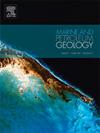沙特阿拉伯坝组叠层石形态的岩石物理意义
IF 3.7
2区 地球科学
Q1 GEOSCIENCES, MULTIDISCIPLINARY
引用次数: 0
摘要
本研究考察了叠层石形态如何影响碳酸盐地层的孔隙度和渗透率,重点研究了柱状(CF)和横向链接(LL)形态。通过强调形态在孔隙度、渗透率和孔隙系统结构方面的关键作用,该研究将现场观察与实验室分析相结合,收集了沙特阿拉伯中新世坝组的40个岩心塞样。这些分析包括岩石学和核磁共振(NMR)技术,以评估岩石结构、纹层特征、孔隙类型和孔隙大小分布。孔隙度和渗透率测量数据与来自现场和实验室数据的详细岩石特征相结合进行分析。研究结果表明,CF和LL叠层石都可以归类为粗粒叠层石,与现代和古代的叠层石相比较。这两种形式都表现出密集的、富含泥晶的层状和高度多孔的、富含颗粒的层状。富粒纹层主要由鲕粒、似球粒、骨架颗粒和石英组成,具有保存完好的粒间孔隙、粒内孔隙和模态孔隙。相反,富泥晶层的特征是凝结的泥晶、凝结的似质体和在层顶保存的弯曲的生物膜。两种层状类型均存在窗状和洞状孔隙。尽管两种类型的孔隙度范围相对较窄(CF叠层石为33.93% ~ 48.04%,LL叠层石为32.28% ~ 54.90%),但它们的渗透率范围都很宽。CF叠层石的渗透率范围为1.38 mD ~ 1900.50 mD,而LL叠层石的渗透率范围为13.31 mD ~ 2017.78 mD。值得注意的是,与高度可变的CF叠层石相比,LL叠层石的渗透率变化较小。尽管岩石学和核磁共振分析对影响渗透率的因素提供了有价值的见解,但结果表明,仅凭这些技术并不能完全解释观察到的渗透率变化,特别是在LL形式中。研究结果表明,孔隙连通性和层状取向等其他因素可能在控制渗透率方面发挥重要作用。样品中纹层结构的设想表明,这些结构可能是影响叠层石渗透率测量的最关键因素。该研究对储层表征具有重要意义,可以更深入地了解含叠层石的碳酸盐岩体系中的流体流动行为。本文章由计算机程序翻译,如有差异,请以英文原文为准。
Petrophysical implications of stromatolite morphologies in the Dam Formation, Saudi Arabia
This study examines how stromatolite morphologies influence the porosity and permeability of carbonate strata, focusing on columnar (CF) and laterally linked (LL) forms. By emphasizing the critical role of morphology in shaping porosity, permeability, and pore system architecture, the research integrates field observations with laboratory analyses of 40 core plug samples collected from the Miocene-aged Dam Formation in Saudi Arabia. These analyses include petrographic and Nuclear Magnetic Resonance (NMR) techniques to assess rock texture, laminae characteristics, pore types, and pore size distribution. Porosity and permeability measurements were analyzed in conjunction with detailed rock characterization derived from both field and laboratory data. The findings reveal that both CF and LL stromatolite forms can be classified as coarse-grained stromatolites, comparable to examples from both modern and ancient settings. Both forms exhibit alternating dense, micrite-rich laminae and highly porous, grain-rich laminae. The grain-rich laminae are primarily composed of ooids, peloids, skeletal grains, and quartz, with well-preserved interparticle, intraparticle, and moldic porosity. In contrast, the micrite-rich laminae are characterized by clotted micrite, clotted peloids, and sinuous biofilms preserved on lamina tops. Fenestral and vuggy porosity are present in both lamina types. Despite having relatively narrow porosity ranges—33.93%–48.04% for CF stromatolites and 32.28%–54.90% for LL stromatolites—both forms exhibit wide permeability ranges. Permeability in CF stromatolites ranges from 1.38 mD to 1900.50 mD, whereas LL stromatolites range from 13.31 mD to 2017.78 mD. Notably, LL stromatolites display less variable permeability compared to the highly variable CF forms. Although petrographic and NMR analyses provided valuable insights into the factors influencing permeability, the results demonstrate that these techniques alone cannot fully explain the observed permeability variability especially in the LL form. The findings suggest that additional factors, such as pore connectivity and laminae orientation, might play a significant role in controlling permeability. Proposed scenarios of laminae configuration in the samples suggest that these configurations may be the most critical factor influencing the measured permeability in stromatolites. This research has significant implications for reservoir characterization, providing a deeper understanding of fluid flow behavior in carbonate systems containing stromatolites.
求助全文
通过发布文献求助,成功后即可免费获取论文全文。
去求助
来源期刊

Marine and Petroleum Geology
地学-地球科学综合
CiteScore
8.80
自引率
14.30%
发文量
475
审稿时长
63 days
期刊介绍:
Marine and Petroleum Geology is the pre-eminent international forum for the exchange of multidisciplinary concepts, interpretations and techniques for all concerned with marine and petroleum geology in industry, government and academia. Rapid bimonthly publication allows early communications of papers or short communications to the geoscience community.
Marine and Petroleum Geology is essential reading for geologists, geophysicists and explorationists in industry, government and academia working in the following areas: marine geology; basin analysis and evaluation; organic geochemistry; reserve/resource estimation; seismic stratigraphy; thermal models of basic evolution; sedimentary geology; continental margins; geophysical interpretation; structural geology/tectonics; formation evaluation techniques; well logging.
 求助内容:
求助内容: 应助结果提醒方式:
应助结果提醒方式:


